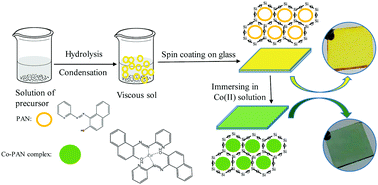Optimization of a doped sol–gel glass with a nanoporous structure as a chemical sensor for the determination of cobalt(ii): analysis of food, pharmaceutical and biological samples
Abstract
We herein describe the fabrication of a 1-(2-pyridylazo)-2-naphthol (PAN) incorporated sol–gel glass with a nanoporous structure as an optical sensor to detect cobalt(II) ions. Tetraethyl orthosilicate was used as a precursor to form a porous polymeric network for the entrapment of PAN in a porous silica gel matrix. In order to modify the pore size, quality and leaching behavior of a sol–gel network, several sols were prepared with different sol–gel pH values and water:alkoxide ratios. Our thorough experimental results revealed that the porous features of the matrix as well as its average pore size could have a significant influence on almost all critical parameters affecting the sensor performance, including the sensitivity, selectivity and response time of the sensor. The FE-SEM technique equipped with EDAX was also used to evaluate the surface morphology, porosity growth and elemental identification of thin films. The sol–gel film was characterized by FTIR spectroscopy. The constructed sensors showed optimum performance under the following working conditions: a water:alkoxide ratio of 4 : 1, a water acidity of 5 M and an ethanolic solution of PAN at 9.6 × 10−3 mol L−1. Under optimum conditions, a linear calibration curve over the cobalt(II) concentration range of 0.007 to 4.000 μg mL−1 (1.19 × 10−7 to 6.79 × 10−5 mol L−1) was obtained, along with a detection limit of 0.002 μg mL−1 (3.39 × 10−8 mol L−1). Meanwhile, the sensor exhibited excellent RSDs for both intra-day and inter-day precision.



 Please wait while we load your content...
Please wait while we load your content...